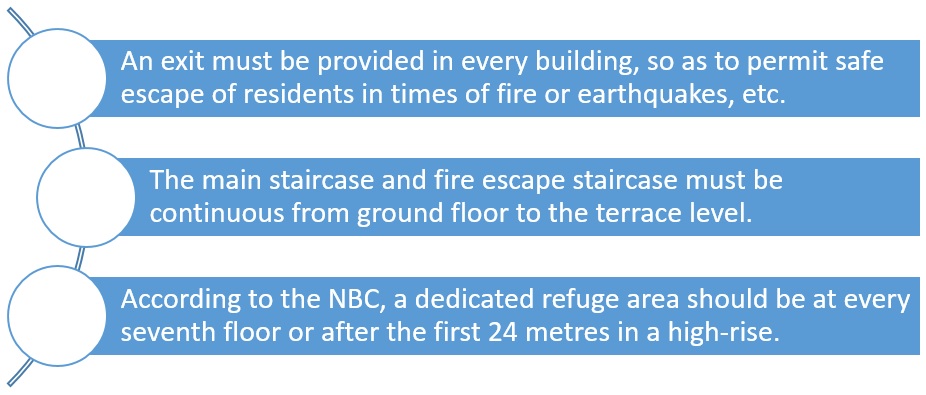The National Building Code (NBC) is a document that provides guidelines for construction of structures – residential, mercantile, institutional, educational, commercial, assembly, storage spaces or even hazardous buildings. It is important to follow these guidelines that are meant to protect the overall health of the construction and ensure the health and safety of the public and the residents. In this article, we are going to talk about the NBC guidelines for residential buildings. These standardised codes were first published in 1970 and revised later in 1983. The latest revision was in 2005.
What are residential buildings as per NBC?
The NBC defines residential buildings as constructions ‘in which sleeping accommodation is provided for normal residential purposes, with or without cooking or dining or both facilities, except any building classified under Group C’.

What are the types of residential buildings?
As per the National Building Code of India, residential buildings include any building that is equipped with sleeping accommodation for normal residential purposes, with or without cooking and dining facilities.
Residential buildings are classified into the following categories:
- Lodging or rooming houses.
- One or two-family private dwellings.
- Dormitories.
- Apartment houses or flats.
- Hotels.
See also: Mobile tower installation rules and regulations
NBC guidelines related to kitchens
- Every kitchen must have provision for washing utensils, with proper connection to drainage.
- The kitchen must be provided with an impermeable floor.
- The kitchen must open into an interior or exterior open space and should not be less than one sq metre.
- The kitchen should not open into a shaft.
- No chutes to be used in buildings above 15 metres.
See also: DTPC full form & DTPC approval
NBC guidelines related to bathrooms
- One of the walls should have an opening to the open air. Minimum ventilation or window space should be provided measuring up to 0.37 sq metre.
- A bathroom must always be over another bathroom or washing place or the terrace space and not over another room. Watertight floors can be an exception to this rule.
- The seat should be made of non-absorbent material.
- Bathrooms should be enclosed by partitions/walls, provided with an impervious surface with a height prescribed as not less than one metre.
- The floor covering should be impervious too but sloping towards the drain and not towards any other room or balcony space.
- A room provided with a water closet is to be used as a toilet only. These rooms must be provided with flush cisterns.
- If there is a toilet on the terrace with a height of 2.2 metre, it should be counted in the Floor Area Ratio (FAR).
- In the absence of a sewage outlet, a septic tank must be provided.
NBC guidelines related to lofts
- Apart from shops, lofts are permitted in residential buildings only.
- The area of the loft should be restricted to 25% of the covered area.
- The height between the loft and ceiling should not be less than 1.75 metre.
NBC guidelines related to basements
- The minimum height of the basement should be 2.5 metre and the maximum height 4.5 metre.
- The ceiling height should be a minimum of 0.9 metre and maximum of 1.2 metre above the road surface.
- Ventilation is must for the basement and could be in the form of blowers, exhaust fans, air-conditioning, etc.
- Surface drainage should not enter the basement.
- The basement’s walls and floors must be water-proof.
- The basement should not be accessed directly from the road. It should be accessed only from the main entrance or an alternative staircase that provides access to the building.
- Only when a projecting basement is flush with the ground, or if the authority allows, can the basement be permitted to touch the adjacent property.
NBC guidelines related to garages
- The plinth of the garage at ground level should not be less than 15 cm.
- Garages should not block access to the building in any way. It should be behind the building line of the street or road. In case it is not, the authority may even discontinue its use as a garage or suggest other alterations.
Guidelines related to building sites
- In case of damp sites, the surface of the ground and space between the walls has tobe declared damp-proof, to the satisfaction of the authority.
- Building sites should be away from electric lines.
| Type of electric line | Vertical distance | Horizontal distance |
| Low and medium voltage lines and service lines | 2.50 metre | 1.20 metre |
| High voltage lines up to and including 11,000 volts | 3.70 metre | 1.20 metre |
| High voltage lines above 11,000 volts and up to and including 33,000 volts | 3.70 metre | 2.00 metre |
| Extra high voltage lines additional 33,000 volts | Plus 0.3 metre for every additional 33,000 V or part thereof. | Plus 0.3 metre for every additional 33,000 V or part thereof. |
- The Master Plan and land development rules and regulations of the authority decide the minimum size of the site.
Also read about HOBPAS login: Everything about Haryana Online Building Plan Approval System
Guidelines related to building exits
The NBC has guidelines for the entry, as well as exit points in buildings.
- An exit must be provided in every building, so as to permit safe escape of residents in times of fire or earthquakes, etc.
- Exits are compulsory and these should be clearly visible to all and must be illuminated. These cannot be reduced in number, width or by any other means. The requisite number is dependent on occupancy load, capacity, travel distance, etc.
- Alarms are necessary to ensure those in danger are evacuated promptly.
- Exits should be continuous, leading to the exterior of the building.
- Exits can be horizontal or vertical.
- Lifts and revolving doors are not exits.
NBC guidelines regarding fire safety
In large-sized buildings where accidents due to fire may not be easily noticed, automatic fire detection and alarm facilities are a must and should be provided. Not just this, such buildings should be provided with and protected by fire extinguishers, wet risers, automatic sprinkler installations, etc. These shall be in accordance with the set standards.
Capacity of exits in different types of buildings
| S No | Group of occupancy
|
Number of occupants |
||
| Stairways | Ramps | Doors | ||
| 1 | Residential | 25 | 50 | 75 |
| 2 | Educational | 25 | 50 | 75 |
| 3 | Institutional | 25 | 50 | 75 |
| 4 | Assembly | 40 | 50 | 60 |
| 5 | Business | 50 | 60 | 75 |
| 6 | Mercantile | 50 | 60 | 75 |
| 7 | Industrial | 50 | 60 | 75 |
| 8 | Storage | 50 | 60 | 75 |
| 9 | Hazardous | 25 | 30 | 40 |
Source: NBC, occupants per unit exit width
Guidelines for staircases in residential buildings
- For group housing, where the floor area does not exceed 300 sq metre and the height of the building is not over 24 metre, a single staircase may be acceptable. In buildings that are identified in Bye-Laws No 1.13 VI (a) to (m), a minimum of two staircases are compulsory.
- In a residential low-rise building, the minimum width for the stairways is 0.9 metre.
- For flats, hostels, group housing, guest houses, it is 1.25 metre.
Guidelines for stairways in residential structures
- The interior stairs must be constructed of non-combustible material only.
- It must have one side adjacent to an external wall and should be completely enclosed.
- It is the chief fire officer who needs to approve of the staircase’s location.
- The minimum height of handrails should be 100 cm.
- The minimum width of treads, staircase, its arrangement, headroom, needs to follow the standards as prescribed by the NBC.
- Living spaces and stores cannot open up into the staircase.
- The main staircase and fire escape staircase must be continuous from ground floor to the terrace level.
- No electrical shafts or AC ducts and gas pipelines can run through the staircase.
- Nothing that is combustible can be used for decoration or panelling of the staircase.
- Beams and columns should not reduce the headroom or width of the staircase.
Guidelines on open areas in residential structures
- Every room, habited by people, should open into an exterior or interior open space or verandah.
- Open spaces should be counted in the FAR, as per the master plan.
- These areas should be free of erections of any kind, except cornice, chajja or weather shade that is not more than 0.75 metres wide.
- Every interior or exterior or air space should be maintained for the benefit of such building exclusively and shall be entirely within the owner’s own premises.
See also: Norms pertaining to refuge areas in high-rise buildings
FAQs
What is the building Code of India NBC?
Created by the BIS, the National Building Code of India 2016 is a national instrument that provides guidelines for construction of buildings in India.
What are the types of buildings as per NBC?
Residential, educational, institutional, assembly buildings, industrial buildings, storage buildings etc. are some of the types of buildings as per NBC.
Is National building Code of India mandatory?
While initially it was a voluntary code to be followed, after it was incorporated as part of the local bye-laws, it is mandatory to follow.
What are the objectives of the National building Code?
The NCB makes sure that the building that is constructed meets structural and safety conditions.
Who formulated NBC of India?
The National Building Code of India (NBC of India) is formulated and published by the Bureau of Indian Standards (BIS). It provides guidelines for construction activities, maintenance and fire safety of buildings.
Are lightning conductors good and useful as per National Building Code?
Yes, as per the NBC, the lightning rod protects buildings. Electrical and other equipment can be protected to a great degree, by installing lightning arrestors.
What is the minimum open area requirement in buildings that are 55 metres or more in height?
The minimum exterior open spaces around buildings that are 55 metres or more, should be 16 metres. On sides where no habitable rooms face, a minimum space of 9 metres shall be left for heights above 27 metres.
What does the National Building Code say about parapets?
Parapet walls and handrails provided on the edges of roof terrace, balcony, etc., should not be less than one metre and more than 1.5 metres in height, as per the NBC.
| Got any questions or point of view on our article? We would love to hear from you. Write to our Editor-in-Chief Jhumur Ghosh at jhumur.ghosh1@housing.com |

With 16+ years of experience in various sectors, of which more than ten years in real estate, Anuradha Ramamirtham excels in tracking property trends and simplifying housing-related topics such as Rera, housing lottery, etc. Her diverse background includes roles at Times Property, Tech Target India, Indiantelevision.com and ITNation. Anuradha holds a PG Diploma degree in Journalism from KC College and has done BSc (IT) from SIES. In her leisure time, she enjoys singing and travelling.
Email: anuradha.ramamirtham@housing.com











